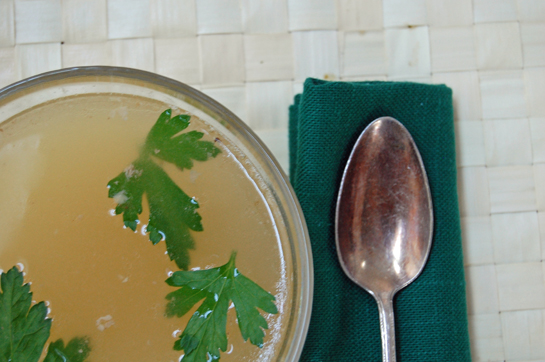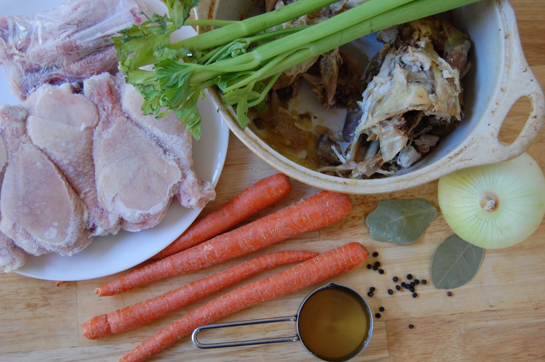While really an essential all year round, chicken broth is especially appreciated once fall rolls around. I definitely consider it a fall essential. As colds and flues start appearing, homemade chicken broth plays it’s historical role of nourishing and protecting those sick. As cold weather appears, it warms tummies and soothes you from the inside out. Chicken broth (or stock) is also an important source of calcium, especially vital for those you don’t drink or eat dairy, but highly beneficial for everyone.
I’ve experimented with many different ways to make chicken broth/stock, but the following recipe is one my most used methods. It balances expense and taste. I personally find that using some leftover bones and some raw bone in chicken pieces make the best tasting broth. But why go through the (very little) trouble of making your own chicken broth? Let me give you 6 reasons.
1) Better use of Resources
Throwing away the bones of chickens is truthfully a terrible waste (though it occasionally happens even in our home). Those bones are full of minerals such as calcium that can be used to nourish your family. I am not a vegetarian, however I feel that we should treat the death of an animal with respect and part of that respect is utilizing every part of that chicken as much as possible.
2) Saves Money
And when we do that, we win be saving money too! We don’t have to buy those expensive “natural” boxes of chicken broth in the store.
3) More Nutritious
Not only do we save money making our own, but it’s so much more nutritious. Even the natural brands are very watered down and poor nutritionally speaking. They use coloring (natural ones) and “natural flavorings” often to make up for the poor quality of the stock. Less natural brands can be full of refined salts and MSG. Making your own broth gives you a mineral rich, nutritious base for all sorts of wonderful meals.
4) It Tastes Better
Are you really that surprised that homemade broth tastes better? Good nutrition is most always paired with superior taste. We love homemade broth so much that we will sometimes sip it in mugs simply salted. (Yes, you will need to add salt).
5) Improves Your Cooking
A good homemade chicken broth gives you the foundation for making delicious soups and sauces and a myriad of other uses. You can cook your grains and legumes in it for extra nutrition and taste (which helps improve mineral absorption if you are concerned about phytic acid’s impact). You can flavor stir fry’s, chicken pot pie, taco filling and many other dishes with it. Having chicken broth on hand gives you the ability to make some wonderful dishes easily.
6) Gives You Many Health Benefits
Besides the rich nutrition you get from it, you also get other health benefits. An excellent (long) article on the topic was published by the Weston Price Foundation, called Why Broth is Beautiful. Here we learn that the gelatin rich broth helps the digestibility of our entire meal, supports liver function, as well as aiding bone and teeth health through the easily absorbed minerals.
I hope that if you aren’t already sold on homemade chicken broth’s benefits that you soon will be! I try to make a pot of it every week and can easily use it up for our family of three in that same week. It’s one of the most simple things you can make in the kitchen too. I have made chicken broth many ways, such as using chicken necks and backs, all leftover bones stripped of the meat, all raw meat on bones, using all whole vegetables, using leftover vegetable scraps saved from a week of chopping etc. All to say, the art of making your own chicken broth is very, very flexible. The following recipe is what I use most often as I have found that it results in a delicious tasting broth, is frugal and I get consistent results from it.
To increase the calcium of your broth, make sure you add the apple cider vinegar to the stock and that you cook it for long periods of time-12-24 hours, but not beyond that time as off flavors can start to develop. It was found in more than one study that the calcium content increases through length of cooking time when in an acidic liquid. (1) You can also let the bones sit in the acidic water for about an hour before heating. This may allow more minerals to leech from the bones.
Many find using their slow cooker the easiest way to make homemade chicken broth, though I still hesitate in cooking an acidic liquid for long periods of time in slow cookers which may contain levels of lead that could potentially be leeched out. However, this is a very easy way to maintain the right temperature.
Chicken Broth1 chicken carcass (or a bag of drumstick bones from the freezer, see note below)
1-2 pound of raw drumsticks or chicken legs (I keep mine ready and frozen in the freezer)
3-5 chicken feet (see note below), optional (I also keep these frozen in the freezer)
Any gizzards from the cavity of the chicken, taken out before cooking, optional
4 carrots, scrubbed and cut into 3 inch pieces
4 celery, washed and cut into 3 inch pieces
1 onion, peeled and cut in half
1 bay leaf, optional
15 peppercorns, optional
A few sprigs of thyme , optional
¼ cup of apple cider vinegarDump all of the ingredients into a large stock pot and cover with filtered water about an inch or two above the top of the ingredients. To draw out more of the calcium from the bones, let sit for an hour at this point at room temperature, optional. Bring to a low simmer and cover. You should never boil stock. Keep at a very low simmer for 3-24 hours, skimming any foam that may rise to the top. The longer you simmer the more flavor and minerals leach out into the water. I find that 12 hours work well for me, go past 24 hours and it will become bitter and too dark.Once done, cool slightly and then pour through a colander. You can further strain the broth by pouring through cheesecloth, though I never bother.
You can also make this using a slow cooker, using the same directions as above and cooking on low.
Whenever I make drumsticks or any other type of chicken on bone, I stick them in a freezer bag and place them in the freezer until we have enough to make a pot of stock. Although it seems a little strange at first to save bones that people have eaten off, a 12 hour simmer is going to kill any “coodies”. But if you would rather, just have your family cut their meat off the bones.
Regarding the chicken feet, some find this practice barbaric, however remember that using all parts of the chicken show proper respect to the chicken. The feet are an excellent source of gelatin. Find them at Asian stores or from local farmers.
Source: 1) http://www.springerlink.com/content/p7u013w7360016w2/
Latest posts by KimiHarris (see all)
- 2 Ingredient Peppermint Bark - December 21, 2022
- Herbal Hibiscus Lemonade (Keto, THM) - March 16, 2022
- Creamy Curry Red Lentil Soup - December 8, 2021


What do I do with the mushy carrots/celery/onion once the broth is done?
Brody,
Compost. 🙂
Hi! Thank you for this article, great source of information. I have a question, please,
How do you define ‘to simmer’ … I am confused atwhat temperature I should simmer the chicken broth, because somewhere it says that simmer means to cook it under the point of boiling, but I wonder if I cook it for 12 hours on this temperature that the water will evaporate. I am new to this kind of cooking, thank you so much for your help!! Jitka
After simmering my chicken broth overnight I usually take the larger bones (leg bones usually) put them on a cutting board, cover with parchment paper and smash with a hammer in order to get to the marrow. I then scrape the shattered bones and marrow into the broth and continue simmering. Does anyone else do this? I haven’t seen breaking the bones open suggested any where else?
I have done something similar, only I usually just smash the soft ends with my fingers, or make deep cuts in them with a knife if they aren’t soft enough to use my fingers.
Hi There…just a quick question: If I don’t have any raw chicken, can I just use previously cooked chicken legs?
Thanks much! Excited to try this.
Kim, thank you for posting this. Bonus, save your eggshells to throw in as well- really! The apple cider vinegar will leach out the minerals. For another bonus if you have a cat or dog, leave out the onion (they can’t have). When done, pour off what you want for the pets then add onion and simmer some more. Kim, it’s not weird to save the “family eaten bones”. I do that too.
Hi Kimi,
I buy rotisserie chickens at Costco and pull off the meat. Is this ok to use? Do I need to remove all meat and skin before using in the broth? If I use only this, no organs or any other bones, do I use only one or should I use two? I normally buy 3 a week, do you think I can freeze the carcass to use later?
Thanks,
Sarah
Hi Sarah, you can use as much meat in the making of your broth as you like, you will only get a richer broth. I also buy those rotisserie chickens from the store. I pick just about all the edible meat off the bones and throw the whole carcass, including all the skin and juices into a freezer bag and place in freezer. I get about 3-4 carcasses into a freezer bag. I also take any vegetable trimmings, over the course of a couple months, and I place in a freezer bag. Everything from onions, carrots, broccoli, garlic, herbs, celery and any vegetable that has wilted a little in the fridge goes into this bag. I get about two full bags of each vegetables and chicken and make a nice rich broth out of this. I make about 25 litres each time and can it in 1 litre mason jars. This way, I make broth for free, a by-product of the scraps that would normally be thrown in the kitchen scraps container/compost.